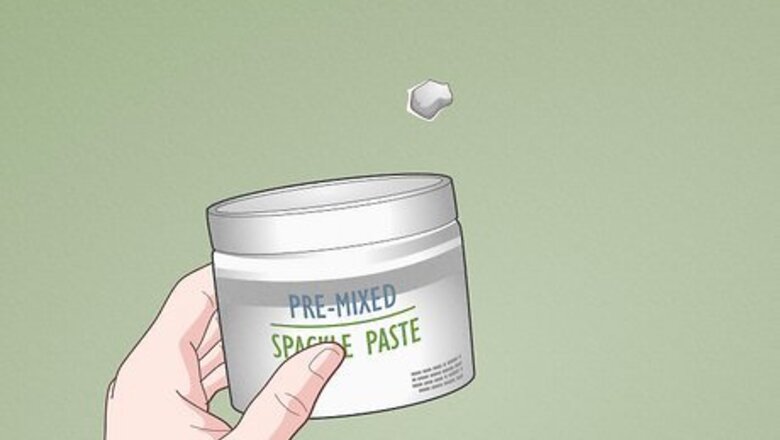
views
- Choose an all-purpose spackling compound for holes less than 1-inch wide and 1/4-inch deep. Use vinyl spackling for holes and cracks that are 3/4-inch deep.
- Apply spackle with a putty knife. Use a smooth, feathering motion to apply three layers. Allow 2-5 hours of drying time between each layer.
- Once the spackle is dry, sand the surface with 150-grit sandpaper. Then, apply primer and paint to match the repair to the rest of your wall.
Use all-purpose spackle for small holes.
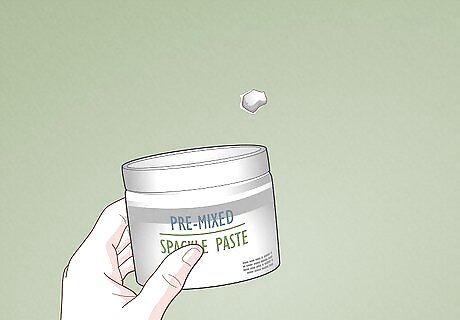
Opt for a pre-mixed spackle paste or a powdered spackle. An all-purpose pre-mixed spackle compound is ideal for holes that are less than 1 inch (2.5 cm) wide and no more than ⁄4 inch (0.64 cm) deep. For holes and cracks that are up to ⁄4 inch (1.9 cm) deep, opt for vinyl spackling, which comes in powdered form. The vinyl adds elasticity to minimize shrinkage. Spackle can be bought in light-weight, heavy-weight, or hybrid options. Using lightweight spackle for smaller nail-hole repairs and dents is best, while heavyweight is better for larger repairs. Hybrid can be used for any project size, ideal for people with various repairs they need to tackle.
Smooth the surface.
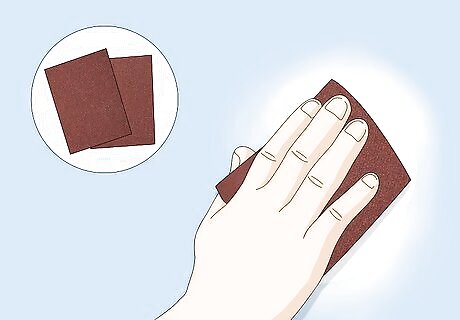
Remove debris from the drywall with 150-grit sandpaper. Place the sandpaper over the hole and rotate it back and forth clockwise and counterclockwise a few times. This keeps your repair area smaller than sanding from side to side. Drywall consists of gypsum, facer paper, and backer paper. When it gets damaged, these materials cause the drywall to splinter, and some smaller fragments may stick out from the wall. If you leave these fragments as is, the spackle won't stick to the wall properly, which is why sanding is necessary. You can also use 100-grit sandpaper if the drywall isn't damaged too badly. If you're patching a small area, like a nail hole, push the drywall in with your thumb or the base of a screwdriver, then spackle over the indent.
Remove fragments and splinters.
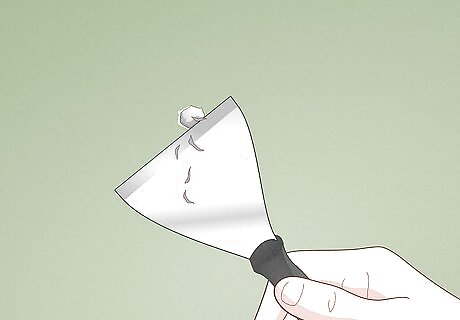
Angle a putty knife against the wall and scrape up and down. Use a putty knife to remove any lingering fragments or splinters the sandpaper couldn’t remove. Be careful not to make the hole in the drywall bigger when using the putty knife. Don't worry about removing paint around the hole. You'll be painting over the area again later on.
Cover large holes with mesh tape.
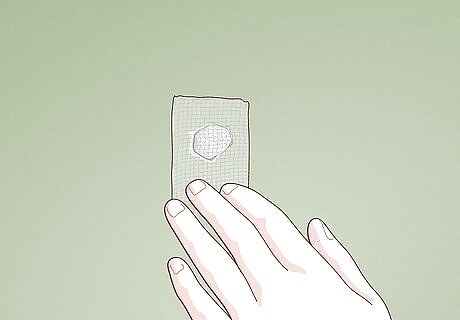
Fill a hole ⁄4 inch (1.9 cm) in diameter with two pieces of mesh tape. Cut a piece of mesh tape about 2 inches (5.1 cm) long. Stick some mesh into the hole with your finger to give the spackle a solid base to adhere to. Then, cover the hole with a piece of mesh tape to repair the hole before spackling.
Mix the spackle compound if needed.
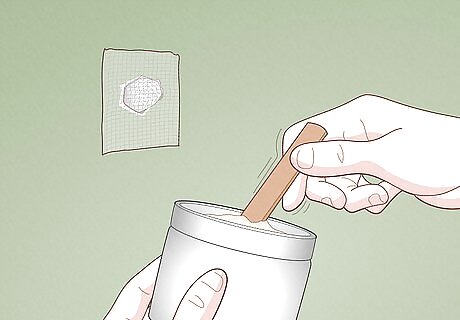
Add equal parts of powdered spackle and water. Combine the powdered compounds according to the manufacturer's instructions. It's best to work with less and mix more as needed so you don't waste any. Mix the compound with a mixing paddle or a similar tool until it's stiff enough to hold onto the putty knife without sliding off.
Apply spackle to the wall with a putty knife.
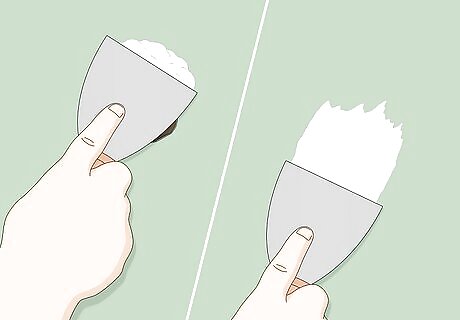
Use a smooth, feathering motion to apply spackle to the drywall. Use enough spackle to cover the hole and scrape around the surrounding area. For deeper holes, apply spackle to the area ⁄4 inch (0.64 cm) deep at a time, allowing it to dry between layers. You can use two putty knives if you want. Use a wider knife to remove the spackle from the tub, and a thinner knife to apply the spackle. Or, use an old plastic credit card or gift card if you don’t have a putty knife. Always close the spackle tub after you've removed the amount you need so it doesn't dry out.
Allow the first layer of spackle to dry.

Wait at least 2 to 4 hours, then sand the spackle. The time it will take your spackle to dry depends on the hole size, how much spackle you applied, and the brand. It may seem time-consuming for deeper holes requiring multiple layers, but it's worth repairing the hole properly. After the spackle dries, sand it down with 150-grit sandpaper before applying a second layer. One layer should be sufficient for nail holes. Test the spackle with your finger to see if it's dry. Your finger should come up clean.
Apply a second layer and let it dry.
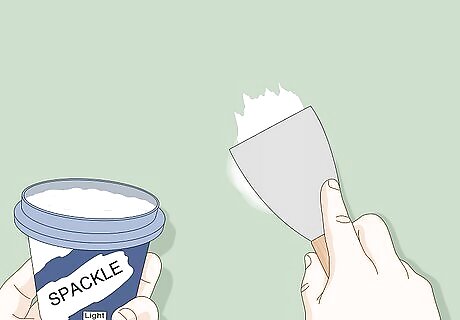
Scrape on another ⁄4 inch (0.64 cm) thick layer of spackle. Use the same feathering and scraping motion as you did with the first layer. Use your putty knife to cover the hole and scrape the spackle around the second layer. Give it 4 to 5 hours to dry before applying a third layer.
Add the third layer.
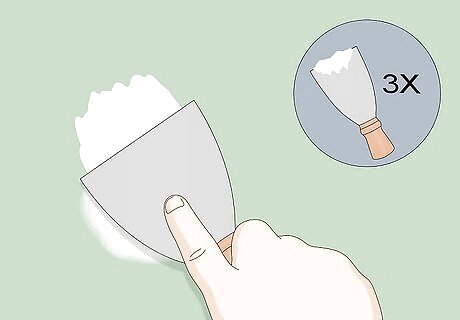
Feather a final layer of spackle once the previous layer has dried. Generally, 3 layers of spackle are enough to cover a hole in drywall. By this stage, the spackle should be very solid. Be sure to sand down the surface with fine-grit sandpaper. You can always apply a fourth layer if the drywall needs it. However, don't overdo it. You may end up with a small lump in your wall from all of the spackle. If your drywall is textured, dab a sponge on the last layer of wet spackle to match the texture of the repair to the texture of the rest of the wall.
Remove excess spackle.
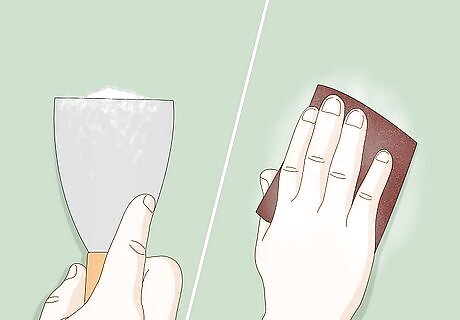
Use a puffy knife and sandpaper to smooth the surface. Once you've applied all your layers of spackle, scrape excess spackle from the drywall with a putty knife. Place your knife at an angle to the wall at the edge of the spackle and scrape across. This will make it easier to prime and paint over. If there's still too much spackle on the wall, use fine-grit sandpaper against the spackle until it's leveled with the wall again.
Primer and paint the repaired area.
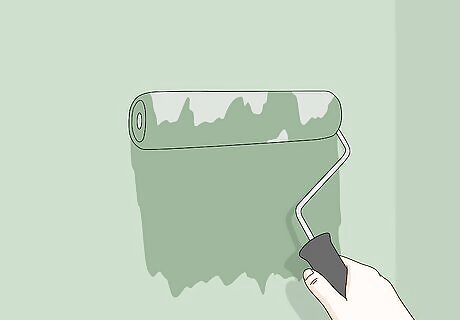
Roll a layer of primer and two layers of paint to the damaged surface. Pour primer into a paint tray and coat a paint roller. To use a paint roller, roll in a narrow V-shape. Generally, primer takes 3 hours to dry. Test it with your finger. Once it's dry, use the same method to apply the first and second coats of paint. If you're only painting the small section you applied spackle to, you can use a small paintbrush or a sponge paintbrush to dab your paint onto the patch. Allow paint coats to dry between 4 to 5 hours between each layer so it fully adheres. To avoid getting paint on your floors, carpet, or baseboards, place a drop cloth or plastic sheet down in the surrounding area. You may need to color-match your paint. You can ask your local painting store or home center for help finding a matching color. Bring paint chips home from the store and hold them to the wall to find the exact color.


















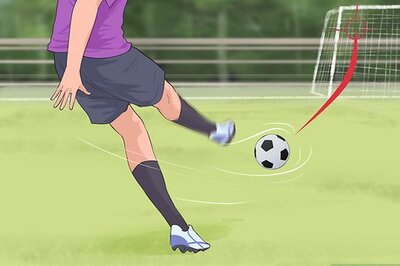

Comments
0 comment